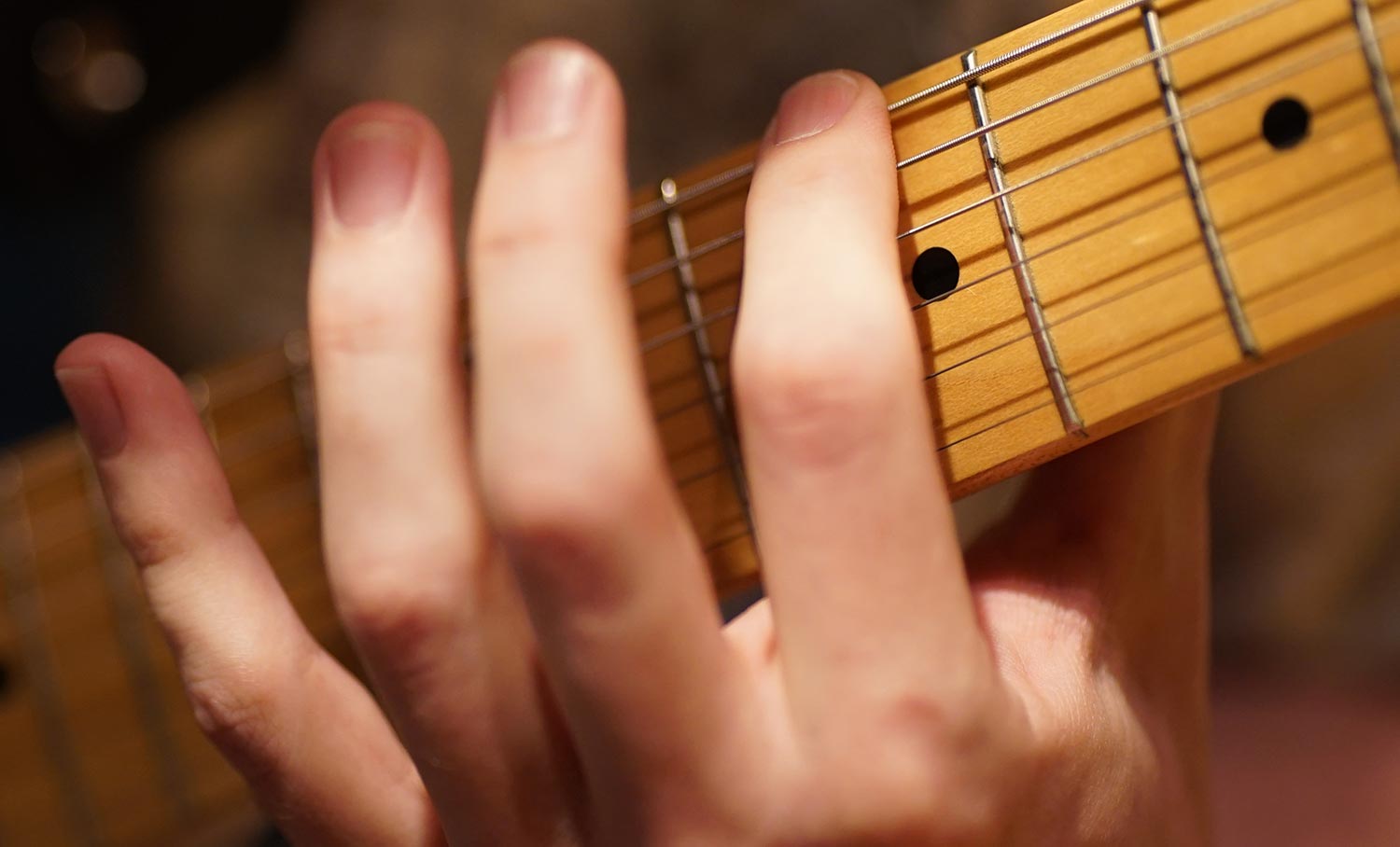Do This To Master Bent-Note Vibrato And Improve Your Lead Guitar Phrasing

EMAIL TO GET ACCESS
By submitting your info, you agree to send it to Tom Hess Music Corporation who will process and use it according to their privacy policy.
If you want to make your guitar solos sound better...
And play awesome lead guitar licks with pro-level guitar phrasing...
There is one lead guitar skill you’d better practice regularly to get there
That skill is...
Applying wide and thick vibrato on top of your lead guitar string bends during your guitar solos.
This style of lead guitar vibrato technique (bent-note vibrato) is one of the hardest guitar phrasing elements to master.
But when you master it...
Everything you play will sound pro (even if you don’t play anything fast or advanced).

EMAIL TO GET ACCESS
By submitting your info, you agree to send it to Tom Hess Music Corporation who will process and use it according to their privacy policy.
So, in this lead guitar article...
I’ll help you make your bent-note vibrato a lot better.
When that happens, you'll be able to make your guitar licks and solos sound way better and have a lot more fun.
To begin...
Watch this guitar phrasing video that shows you the basic mechanics of bent-note vibrato:
Now that you understand the basics of bent-note vibrato, let’s go deeper.
Here are 5 more guitar soloing tips that help you level-up your guitar licks with pro-level guitar phrasing.
Lead Guitar Phrasing Tip #1: Get Control Over String Noise
Do you know anyone who loves the sound of sloppy lead guitar playing?
Me neither.
And the key to making your guitar playing sound clean is controlling excess string noise during your guitar licks (and especially – during your bent-note vibrato).
The first thing to understand is: what causes guitar string noise in the first place.
String noise has several causes (all of which can affect your guitar phrasing and make your bent-note vibrato sound bad):
The first cause of string noise is noise from the higher (in pitch – aka thinner) guitar strings.
Then, there is the noise from the lower (in pitch – aka thicker) guitar strings.
Finally, there is noise from the notes ringing together (aka: bleeding) when changing strings.
The noises that affect your bent-note vibrato the most are the first 2 types listed above.
How do you control them when doing lead guitar bent-note vibrato?
My go-to techniques are: picking hand thumb muting and fretting hand index finger muting.
To do thumb muting: simply rest your picking hand’s thumb on the thicker guitar strings and slide it up and down as you play your guitar licks (and do bent-note vibrato).
Here is a demonstration of how to do it:
Note: the big key to doing thumb muting is holding the guitar pick the way I show in this guitar technique video.
Question: “Tom Hess, but what about all the guitar players who mute string noise with the palm? Isn’t that also a valid approach for playing bent-note vibrato (and other lead guitar techniques) cleanly?”
Answer: This isn’t a technique I recommend. There are 2 reasons why. First, thumb muting is more reliable. You can always feel what strings the thumb is covering as you play. This isn’t always the case with palm muting.
Most importantly: thumb muting ensures that your pick is at rest in the trench of (space between) the strings... while palm muting often allows for the pick to (excessively) come out of the strings.
(Unnecessarily) removing the pick outside the trench of the strings not only makes your guitar licks and guitar solos more likely to be filled with string noise but it limits your guitar speed as well.
Here is what I mean:
The second very powerful way to mute string noise in your guitar phrasing is to use the index finger of your fretting hand to mute the higher (thinner) guitar strings.
This is particularly effective when doing bent-note vibrato.
Here is what this style of string muting looks like:

Lead Guitar Phrasing Tip #2: Combine Bent-Note Vibrato With Double-Stops
First, what are lead-guitar double stops?
A double stop happens when you play 2 notes at the same time. It’s a very common effect used in many lead guitar solos (from classic rock to heavy metal).
Note: lead guitar double stops are often confused with unison bends. (This is where you fret 2 notes on 2 strings that are a step apart and bend one of the strings until both notes sound in tune.)
“How can you possibly combine bent-note vibrato with double stops in your guitar licks”, you ask?
Simple: play bent-note vibrato on a single note and ‘then’ add a double stop on a higher (in pitch) guitar string – creating very mean and intense lead guitar licks, like this:
Note: these double stops sound great in all styles – not only classic rock and blues. (Here are more examples of lead guitar double stops shown in other genres of electric lead guitar.)
Also: the string noise control lead guitar phrasing techniques described above become even more important when using double stops in your guitar licks and guitar solos.
Question: “Tom Hess, what if I am not able to keep my string bends and vibrato in tune when playing double stops? What should I do?”
Answer: Tune down your guitar (or use a different guitar you intentionally keep in a lower tuning just for practicing leads guitar string bends and bent-note vibrato).
You can use also lighter guitar strings (temporarily) to achieve the same effect.
As your string bending lead guitar technique improves, you can build up to playing your guitar licks in standard tuning (and/or with heavier guitar string gauge strings, if you want that).
(Fun fact: This is the exact same approach I used myself to get my guitar phrasing (and bent-note vibrato) guitar technique back in shape after I had a serious elbow injury that left me completely unable to play guitar for more than a year. I practiced with my guitar tuned down a whole step for a while, until my finger strength returned to what it was pre-injury.)
Lead Guitar Phrasing Tip #3: Make Your Bent-Note Vibrato Sound Thick.
One of the simplest ways to make your guitar phrasing in your guitar licks sound more pro... is to make your guitar string bends (and bent-note vibrato) sound thicker.
Here are 3 easy ways to do just that:
1. Add string rakes to your bent-note vibrato guitar licks (especially the ones you play on the high E or B strings... and/or the ones you play on the high frets).
To do this, simply brush your guitar pick over the (muted) thicker strings as you approach the string in your guitar lick you are applying bent-note vibrato to.
This effect adds more articulation power to the notes that ordinarily sound thin on their own.
 Create Awesome Rock Guitar Licks
Create Awesome Rock Guitar LicksLearn how to make any guitar lick you play sound absolutely amazing.
 How To Quickly Build Guitar Speed
How To Quickly Build Guitar SpeedLearn the secrets to building guitar speed by watching this free video.
 How To Fix Sloppy Guitar Playing
How To Fix Sloppy Guitar PlayingUse this muting technique to clean up your guitar playing right away.
2. Use the neck pick up on your guitar. The neck pick-up makes your lead guitar licks (and guitar solos) sound thicker. So, switch to this pick up when you have a dramatic string bend coming up that you want to apply bent-note vibrato to.
Pro Tip #1: when you buy a guitar, pay attention to the position of the pick-up selector. Make sure it is within easy reach of your picking hand fingers ‘without’ requiring you to lift your hand away from the strings.
(Ibanez guitars and Fender guitars are good examples of guitars that get this piece right. Guitars like Les Pauls have the pick up selector in the worst possible spot it can be.)
Pro Tip #2: Using the neck pick-up also gives you the smoothest (and – in my opinion – the best) tone for faster lead guitar playing (especially sweep picking).
3. Slide into bends. Combining lead guitar slides with string bends (and bent-note vibrato) can make any guitar lick sound thick and very expressive.
Note: there are many ‘different’ types of lead guitar slides – not just one.
Ascending slides – this is where you slide up to the note in your guitar lick you want to bend from (from a lower in-pitch note).
Descending slides – this is where you slide down (in pitch) to the note in your guitar lick you want to bend from.
Backslides – these slides are often confused with ‘descending’ slides, even though they are not the same.
A backslide happens like this: first you play any note to begin the slide. Then, you quickly slide up (or down) and immediately return to the note you began the backslide from.
Note: the “3” events I described happen as ‘one’ simultaneous sound. (That is what gives backslides their own unique sound.) And when you combine them with string bends (and bent-note vibrato), your guitar phrasing begins to drip with emotion.
Here is a demonstration of backslides in action:
Super slides - to do super slides, you slide a distance of one octave (12 frets) or more. This sounds simple, but the further you slide, the greater the risk of you accidentally landing on the wrong fret (which can make your guitar phrasing sound amateur).
The solution?
Start looking at the fret you’ll be sliding to ‘before’ your hand starts to move to it. This ensures that you arrive on the correct note nearly every time, without embarrassing mistakes.
Rearticulation slides – ‘rearticulation’ is a fancy word for “playing something again”. And a rearticulation slide happens when you play a note and then slide ‘into’ that same note (from above or below in pitch).
These lead guitar slide variations add additional texture to every note and makes your phrasing sound thicker.
Use them all for maximum impact in your lead guitar licks and guitar solos.
Lead Guitar Phrasing Tip #4: Practice Advanced String Bending Variations
Most lead guitarists think that string bends are simple... and rarely practice them.
But string bends can become quite advanced. And I mean that in a good way... because, just like lead guitar slides (and double stop) examples you saw and heard earlier...
‘Advanced’ lead guitar string bends can add a lot of fire to your guitar licks, guitar solos and the way you do bent-note vibrato.
Here are some examples to show you what I mean:
Question: “But Tom Hess, what if I struggle to make my string bends sound in tune? What should I do?”
Answer: Here are some tips for making string bends easier:
Practice playing the note you want to bend up to as a regular unbent note. This gets its pitch into your ears. Then, bend into that note (from 1 or 2 frets below) slowly, stopping when you hear the string reach its target pitch.
Do this many times to make your string bends more consistent (and improve your bent-note vibrato guitar phrasing).
Also practice your lead guitar string bends in half steps instead of whole steps (to make it easier for your fretting hand to bend strings).
(Plus: Detuning your guitar, as well as using lighter gauge strings can also help.)
Lead Guitar Phrasing Tip #5: Create Refinement Variations From Your Guitar Licks
One of the most important lead guitar phrasing skills to practice (that’s sure to improve your guitar licks and guitar solos) is musical refinement.
This means: taking a simple (3-4 note) guitar lick and trying to make it sound more and more expressive with each repetition.
This includes: ornamenting the notes of the guitar lick with bent-note vibrato, slides, double stops, rakes, trills, hammer ons and pull offs to come up with the phrasing variation that sounds the best (to you).
This, by the way, is the #1 guitar skill I still practice to this day. (It’s not something you ever outgrow.)
Here is what practicing lead guitar lick refinement looks like:
Now that you know how to play better guitar licks and guitar solos with pro-level guitar phrasing, the next step is to bring up the consistency of your overall guitar playing. This will enable you to play at (or near) your best, even on your worst days. I show you how in my free eGuide: “The Guide To Playing Guitar Accurately, Consistently And Reliably, Even ON Your Worst Days”. Download it today and discover the guitar playing secrets most guitarists will never know.


Transform your guitar playing with the best electric guitar tuition online.
